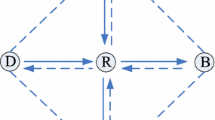Abstract
This paper studies the optimal medium time and energy encoding (OMEE) problem by utilizing multiple power levels and bit rates to improve network coding gain. The OMEE problem is formulated as an integer nonlinear programming and proven to be NP-complete. A heuristic encoding algorithm is proposed after analyzing the relationship of the product of medium time and energy consumption of two nodes. Simulation results show that the proposed encoding algorithm approaches the optimal solution for all performance metrics, and decreases the product of medium time and energy consumption by up to 77.3 and 75.9%, respectively, compared to existing minimal number of transmissions and minimal medium time encoding algorithms. The proposed encoding algorithm also achieves a similar performance gain for medium time over the existing algorithms (excluding the optimal solution).






Similar content being viewed by others
Notes
The value represents the time consumption of sending the data, and is the main time consumption of sending a packet in general. Our analysis can be easily extended to consider the protocol overhead.
References
Ahlswede, R., Cai, N., Li, S., & Yeung, R. (2000). Network information flow. IEEE Transactions on Information Theory, 46(4), 1204–1216.
Yin, X. R., Wang, Y., Li, Z. P., Wang, X., & Xue, X. Y. (2014). A graph minor perspective to multicast network coding. IEEE Transactions On Information Theory, 60(9), 5375–5386.
Lin, H.-T., Lin, Y.-Y., & Kang, H.-J. (2013). Adaptive network coding for braodband wireless access networks. IEEE Transactions On Parallel and Distributed Systems, 24(1), 4–18.
Katti, S., Rahul, H., Hu, W., Katabi, D., Medard, M., & Cowcrof, J. (2006). XORs in the air: Practical wireless network coding. In ACM international conference on the applications, technologies, architectures, and protocols for computer communication (pp. 243–254).
Akhtar, A. M., Nakhai, M. R., & Aghvami, H. A. (2013). On the use of cooperative physical layer network coding for energy efficient routing. IEEE Transactions on Communications, 61(4), 1498–1509.
Xu, L., Zhang, J., Xiang, Y., & Huang, X. Y. (2016). Network coding based converge-cast scheme in wireless sensor networks. Wireless Personal Communications. doi:10.1007/s11277-016-3725-7.
Kamal, A. E., Ramamoorthy, A., Long, L., & Shizheng, L. (2011). Overlay protection against link failures using network coding. ACM/IEEE Transactions on Networking, 19(4), 1071–1084.
Li, L., Ramjee, R., Buddhikot, M., & Miller, S. (2007). Network coding-based broadcast in mobile ad hoc networks. In IEEE international conference on computer communications (pp. 1739–1747).
IEEE 802.11a. (1999, September). Part 11: Wireless LAN medium access control (MAC) and physical layer (PHY) specifications: High-speed physical layer in the 5 GHz Band. Supplement to IEEE 802.11 Standard.
IEEE 802.11b. (1999, September). Part 11: Wireless LAN medium access control (MAC) and physical layer (PHY) specifications: High-speed physical layer extension in the 2.4 GHz Band. Supplement to IEEE 802.11 Standard.
IEEE 802.11g. (2003, June). Part 11: wireless LAN medium access control (MAC) and physical layer (PHY) specifications-amendment 4: Further higher data rate extension in the 2.4 GHz Band. Supplement to IEEE 802.11 Standard.
Wang, Q. S., Wang, Q., Xu, Y. L., & Guo, Q. W. (2010). A minimum transmission time encoding algorithm in multi-rate wireless networks. Computer Communications, 33(2), 222–226.
Bandai, M., Maeda, S., Watanabe, T. (2008). Energy efficient MAC protocol with power and rate control in multi-rate ad hoc networks. In Proceedings of the 67th IEEE vehicular technology conference, VTC Spring 2008 (pp. 66–70).
Chachulski, S., Jennings, M., Katti, S., & Katabi, D. (2007). Trading structure for randomness in wireless opportunistic routing. In ACM international conference on the applications, technologies, architectures, and protocols for computer communication (pp. 169–180).
Garrido, P., Gómez, D., Lanza, J., & Agüero, R. (2016). Exploiting sparse coding: A sliding window enhancement of a random linear network coding scheme. In IEEE international conference on communications (pp. 1–6).
Katti, S., Katabi, D., Balakrishnan, H., & Medard, M. (2008). Symbol-level network coding for wireless mesh networks. In ACM international conference on the applications, technologies, architectures, and protocols for computer communication (pp. 401–412).
Desai, M., Maxemchuk, N., & Klein, T. (2013). A packet encoding algorithm for network coding with multiple next hop neighbor consideration and its integration with delta routing. In IEEE international symposium on a world of wireless mobile and multimedia networks (pp. 1–6).
Feeney, L. M., & Nilsson, M. (2001). Investigating the energy consumption of a wireless interface in an ad hoc networking environment. In IEEE international conference on computer communications (pp. 1548–1557).
Rouayheb, S. Y. E., Chaudhry, M. A. R., & Sprinston, A. (2007). On the minimum number of transmission in single-hop wireless coding networks. In Proceedings of the 2007 IEEE information theory workshop (pp. 120–125).
Acknowledgements
This work is partly supported by Natural Science Foundation of China (61401144, 61571179, 61772167).
Author information
Authors and Affiliations
Corresponding author
Rights and permissions
About this article
Cite this article
Wang, Q., Wang, Q., Wang, X. et al. An Encoding Algorithm for Minimizing Medium Time and Energy in Wireless Networks. Wireless Pers Commun 98, 1103–1117 (2018). https://doi.org/10.1007/s11277-017-4910-z
Published:
Issue Date:
DOI: https://doi.org/10.1007/s11277-017-4910-z




